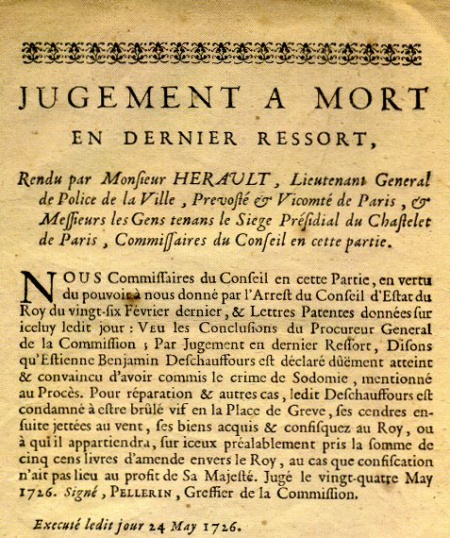"In France the nobility, in Spain the clergy and in Italy everyone!"That is how a contemporary quote described what was then known as sodomy but is now known as homosexuality. Indeed, most Frenchmen agreed with the idea that homosexuality had originated in Italy and consequently it was referred to as "the Italian vice" (in Italy they retorted by promptly naming it "the French disease"). So, let's take a look at how the "vice" struck the core of French power.
 |
| Philippe, Duc d'Orlèans |
Philippe, Duc d'Orlèans - brother of Louis XIV - is probably the most famous homosexual man at the court of Versailles. Knowing that his almighty brother highly disapproved of homosexuality Philippe used it as the only weapon he had to show his displeasure of the King's choices. Consequently, whenever the King made a decision concerning his brother (for example his marriage) Philippe would openly flaunt his sexuality much to the annoyance of his brother. It should be said that Louis never acted against his brother's sexuality but the reason therefore is not out of brotherly compassion; Louis knew that Philippe could never pose a threat to the throne when it was publicly known that he was a so-called sodomite. So, Louis let Philippe continue his outburst knowing that his brother truly had no other weapon.
Over time an entourage would gather around Philippe whose members would often be in some way connected with homosexuality. Thus the King's brother created a safe haven for those whose tastes were not approved of elsewhere.
Sadly, common people were not so fortunate to escape persecution. The penalty for "sodomy" was death and quite a few went to their deaths on this account. In this respect the courtiers were far safer than their subjects since they would hardly ever be executed but rather exiled if things got too far. The common point of view throughout the Ancien Regime was that homosexuality was something best kept in the dark.
 |
| Duc de Boufflers |
In the beginning of the 1720's (around 1722) a scandal arose at court involving homosexuality. The Duc de Boufflers and the Marquis d'Alincourt were both exiled from court following "sexual escapades" - not necessarily with each other - and when the young Louis XV asked where these gentlemen had gone, he was informed that they had been sent away for destroying some fences in the garden. Still, despite the increased measures taken to contain the spreading of the "vice" more and more courtiers and people of note were becoming involved with the subject. Louis XV's governor, the Marècal de Villeroy, was found out to be in a relationship with the First Gentleman of the King's Bedchamber named La Trémoille. An even larger scandal erupted when the son of a man of state (Benjamin Deschauffours) was discovered to have run a brothel of male prostitutes particularly for the court's use! He was later burned at the stake.
 |
| The announcement of Deschauffours' death punishment. As you can see his execution was scheduled for 24 May 1726 |
Despite that Deschauffours' fate was meant to be a warning, it had little effect on the courtiers. By the standards of the time nothing was really done to the noblemen who practised this "vice". In 1726 the Marèchal d'Uxelles was openly displaying his sexuality without evoking a single punishment. Again in 1729 a Marquis who last name is lost to history was returned to his offices after a short "break" on account of his sexuality. Another unknown Marquis made open advances to a guard on the terraces of Versailles itself!
This tendency to cover up is exactly why Louis XVI refrained from passing a statue against homosexuals in 1784, it was better not to bring attention to it. The list of courtiers who indulged in their same-sex passions continued to grow throughout Louis XVI's reign. The Ancien Regime's homosexual courtiers were married nonetheless in order to improve the line's standing, mostly to women who would themselves found other lovers.
While the view of homosexuality from the three Kings' point of views were different from one another they were all opposed these tastes. Louis XIV had openly disliked it, Louis XV seemed rather indifferent to it and probably only had the aversion common at the time and Louis XVI was just as prudish about homosexuality as he was about his own heterosexuality.
These are some courtiers who connected with the "Italian tastes":
Philippe, Duc d'Orlèans
Duc de Boufflers
Marèchal de Mouchy
Marquis de Crénolles
Marquis d'Alincourt
Comte de Besenval
Marèchal de Villeroy
Marquis de Chambonas
Baron de Milleville
Marèchal d'Uxelles
Prince de Bouillon
Marquis de Villette

No comments:
Post a Comment